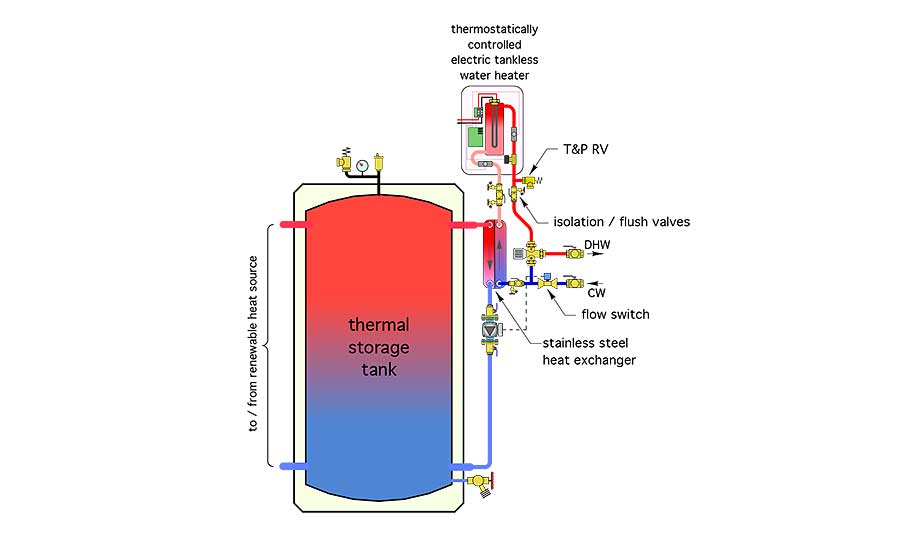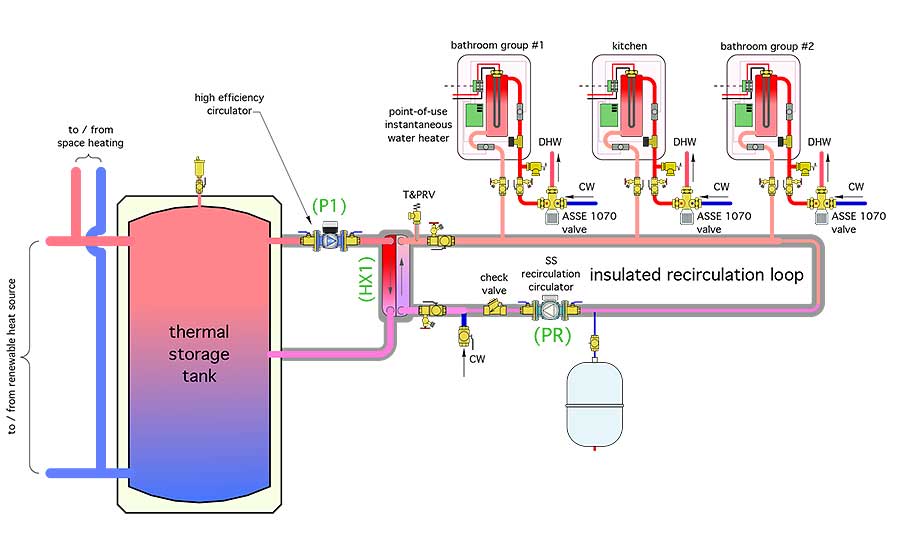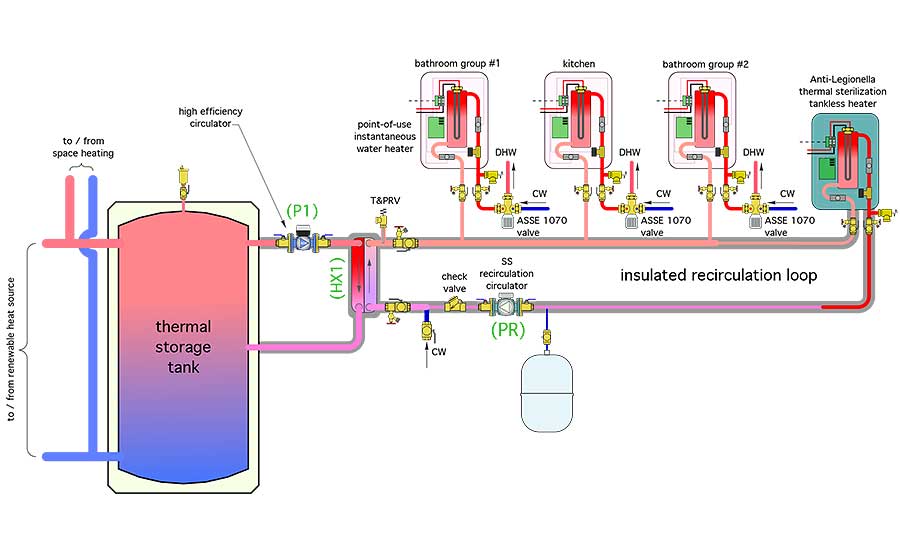John Siegenthaler: Low temperature leverage
A novel hardware combination offers several benefits.

Because they generate heat intermittently, renewable energy heat sources such as solar thermal collectors and pellet boilers require thermal storage tanks. So do storage-based systems using off-peak electricity, or micro combined heat and power (MCHP) generation.
The temperature of the thermal storage tanks in these systems can vary over a wide range. If supplied by a solar collector array, the tank temperature could be upwards of 180° F following a couple of sunny days with minimal heat demand. These temperatures are also possible when a pellet boiler finishes “charging” its thermal storage tank.
At other times, when there’s little if any heat input from the renewable energy heat source, the thermal storage tank could cool down to the surrounding air temperature.
This temperature variation implies there will be times when thermal storage could supply all the energy needed to heat domestic water to a typical maximum delivery temperature of 120°.
There will also be times when thermal storage can “preheat” domestic water. In this case, another heat source, such as tankless water heater, would be used to “top off” the water to the required delivery temperature.
Preheat and recirculate
Even though preheating doesn’t bring the domestic water all the way to the final temperature, its importance shouldn’t be underestimated. Keep in mind that it takes just as much energy to bring a quantity of water from 50° to 60°, as it does to bring that water from 150° to 160°. Thermal storage tanks, even at reduced temperatures, can “leverage” the low end of the temperature rise. Because of this, domestic water heating, where it’s needed, is an appealing load to match with renewable energy heat sources.
> FIGURE 1.
Figure 1 shows how heat from thermal storage can be transferred to domestic water using a single pass stainless steel heat exchanger.
A flow switch closes its contacts when it detects a specific minimum flow rate of cold domestic water. This turns on a circulator that routes water from the upper portion of the thermal storage tank through the primary side of the brazed plate stainless steel heat exchanger. Heat is transferred to the domestic water passing in counterflow through the secondary side of the heat exchanger.
Brazed plate heat exchangers have a high ratio of internal surface area to fluid volume. They can respond very quickly to temperature changes. With the heat exchanger and circulator located as close as possible to the tank, the response time from when the flow switch closes, to when heated domestic water emerges from the secondary side of the heat exchanger, should be in the range of 2-3 seconds.
The temperature of the domestic water leaving the heat exchanger obviously depends on the temperature in the upper portion of the thermal storage tank. With a generously sized heat exchanger, the approach temperature difference should be no more than 5°. A thermal storage tank at 95° could potentially heat domestic water from 45° to 90°. That’s 60% of the temperature rise, and 60% of the energy required to fully heat that water to 120°.
A thermostatically-controlled electric tankless water heater provides the final portion of the temperature rise, when required. If the domestic water enters this heater at or above the required delivery temperature, the elements in the heater do not turn on.
An ASSE 1017-listed thermostatic mixing valve provided protection against high DHW delivery temperature in situations where the thermal storage tank is at an elevated temperature, and thus the domestic water leaving the heat exchanger is “overheated” relative to the target delivery temperature.
Both the heat exchanger and tankless water heater are equipped with combination isolation/flushing valves. This allows for citric acid washing if necessary to remove any accumulated scale.
Add a recirculation loop
The system in Figure 1 doesn’t ensure that domestic hot water, at the required temperature, is instantly available at every fixture. That requires a recirculation piping system. The system in Figure 2 adds a recirculation loop, along with several point-of-use electric tankless water heaters to the heat exchanger/ circulator subassembly shown in Figure 1.
> FIGURE 2.
Each point-of-use tankless heater draws heated water from the recirculation loop. A typical system would use one tankless heater for each bathroom group (shower/tub and lavatory). It would use separate tankless heaters for the kitchen, laundry or other areas where DHW is required. Each tankless heater would be sized to the flow and delivery temperature requirements of these loads. Each would be controlled by it’s internal thermostat so only the energy necessary is added to the entering water. If the entering water is already at or above the required temperature, the elements within these heaters would not operate. An ASSE 1070-listed thermostatic mixing valve ensures that the water delivered to the fixtures doesn’t exceed a safe delivery temperature.
A small stainless steel recirculation circulator moves water around the loop whenever DHW may be required in the building. This is not necessarily 24/7. The recirculation circulator can be controlled by a timer or a manual activation button located near fixtures.
Another small high efficiency circulator maintains flow between the thermal storage tank and stainless steel heat exchanger.
Assuming an upper tank temperature of 120°, a high efficiency circulator between the tank and a 5-inch x 12-inch x 50 plate heat exchanger could yield an output of 4 gpm of domestic water heated from 50° to 115° on a power input of about 30 watts. A small recirculation circulator would add another 12 watts of power input. If both circulators ran continuously in a location where electricity costs $0.15 per kWh, the operating cost would be about $0.15 per day. This could be reduced by turning off the recirculation system during times with little or no expect demand for DHW.
Even when the recirculation system is off, each tankless heater can provide some hot water to its associated fixture(s) with energy supplied solely by electricity. The flow rate and delivery temperature would depend on the power rating of each tankless heater.
The check valve downstream of the recirculation circulator forces domestic cold water through the heat exchanger whenever hot water is drawn from any fixture.
Niceties
This approach has several advantages. First, the power requirement of each tankless heater is only that required for the fixture group it serves. For example, a 7 kW tankless heater would provide up to 1.9 gpm flow rate with a corresponding temperature change from a “preheat” temperature of 95° to a delivery temperature of 120°. A 7 kW tankless heater could be supplied from a 240 VAC / 30 amp circuit. Higher capacity tankless heaters could be used where higher flow rates are needed.
Second, multiple tankless units also provide redundancy relative to a single higher capacity heater. A problem with one unit doesn’t prevent DHW availability at the other units.
Third, when the water in the recirculation loop is at a lower temperature, heat loss from the loop is reduced. Still, the recirculation loop should always be insulated.
Killing bugs
Any domestic hot water system operating at water temperatures in the range of 68° to 122° has the potential for legionella bacteria growth. Tempered water between 77° and 113° provides an optimum growth environment.
Several well-publicized Legionella outbreaks associated with domestic hot water plumbing, typically in hotel systems, have spurred interest in designing DHW plumbing systems to minimize harmful levels of the bacteria. It’s possible (even likely) that mandatory Legionella protection standards will be coming to both commercial and residential DHW systems.
> FIGURE 3.
To address this, the system from Figure 2 has been further detailed with a dedicated thermal sterilization tankless heater, as shown in Figure 3.
The purpose of the sterilization heater is to periodically elevate the water temperature in all portions of the recirculation loop to a relatively high temperature and maintain that temperature long enough to kill Legionella bacteria. In the absence of specific codes that require otherwise, typical daily thermal sterilization temperature/cycle durations are as follows:
158° F (70° C) for 10 minutes
149° F (65° C) for 15 minutes
140° F (60° C) for 30 minutes
The sterilization cycle could be set to occur at times of low (or no) DHW use, such as early morning hours. If one assumes no DHW draws during this relatively short sterilization cycle, the power output of the sterilization heater is only that required to match the heat loss of the recirculation loop.
For example: Assume the DHW loop consisted of 100 feet of 1-inch insulated copper tubing on the supply side, and 100 feet of 1/2-inch insulated copper tubing for the recirculation piping. The insulation is 1/2-inch thick elastomeric foam. Also assume an average water temperature in the loop of 155° during the sterilization cycle. The total heat loss of the piping is about 2,700 Btu/h. Add 20% to this to account for heat loss from riser piping to fixtures, heat loss from the insulated heat exchanger and more heat loss from the recirculation circulator, valves, etc. The total estimated 3,240 Btu/h heat loss is just under 1 kW (3413 Btu/h). Even a small 3 kW electric tankless unit is more than enough capacity to achieve the (no DHW draw) sterilization requirements. Higher capacity sterilization heaters could provide sufficient heat input to allow some DHW draw during the sterilization cycle. The ASSE 1070 mixing valves on each fixture prevent scalding temperatures from reaching the fixtures.
A system controller could determine when the sterilization cycle begins, and monitor the water temperature returning to the sterilization heater (e.g., the coolest water in the recirculation loop during the sterilization cycle). The cycle would continue until a prescribed minimum temperature/time criteria has been verified.
Due to its low starting temperature, domestic water heating is a very “attractive” load to be supplied by renewable energy heat sources. This concept takes advantage of the low starting temperature. It also ensures consistent, safe and immediate DHW delivery at all fixtures, and minimizes the potential for harmful levels of Legionella bacteria to reach any fixture. Perhaps you can put these concepts to use in an upcoming system.
To read Siegenthaler’s article: “Low temperature leverage” in pdf form, please see here.
Looking for a reprint of this article?
From high-res PDFs to custom plaques, order your copy today!










